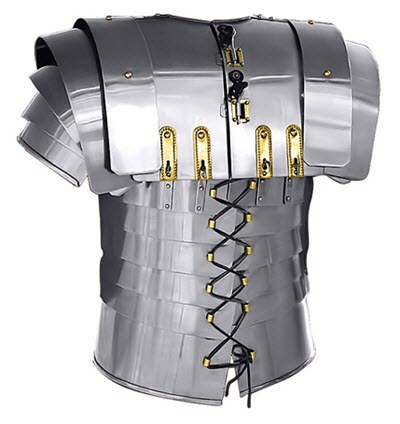Contents
The lorica segmentata is one of several types of personal armor worm by soldiers of the Roman Empire. We don’t know what the Roman’s themselves called this armor; the name lorica segmentata was invented in the 16th century. As this 16th century name suggests, this is a segmented type of armor. It consists of metal strips fastened to internal leather straps.
 In our time, the lorica segmentata has become somewhat of a symbol of the Roman soldier. In works of fiction, Roman legionaries are often depicted wearing lorica segmentata even when it is historically inaccurate for them to do so, since the story is taking place either to early or to late.
In our time, the lorica segmentata has become somewhat of a symbol of the Roman soldier. In works of fiction, Roman legionaries are often depicted wearing lorica segmentata even when it is historically inaccurate for them to do so, since the story is taking place either to early or to late.
Configuration
A common plate design was the one were soft iron formed the inside and mild steel the outside.
The strips were arranged horizontally on the body, overlapping downwards. The soldier’s torso would be embraced by two halves of strips that needed to be fastened both in the front and in the back. Additional strips were used to protect the upper body, where the solider would also have breast- and back plates.
The fitments (fasteners) were made from brass. The outfit required quite a lot of brass fitments, including buckles, tie-hooks, tie-rings, and hinges.
Later versions
During the first century AD, simplified versions of the lorica segmentata begin to appear, especially from the year 75 AD and onward. Instead of bronze hinges, they had simple rivets, and the belt fastenings relied on small hooks. The lowest two girdle plates had been replaced with just one broad plate.
History
In the monument commemorating the conquest of Dacia by Emperor Trajan (who ruled 98-117 AD), we can see both legionaries and auxilia. This monument, which was erected in Rome in the year 113, the legionaries are shown wearing lorica segmentata while most auxilia are wearing lorica hamata. Historians have therefore speculated that during this period, lorica segmentata might have been a type of armor used by legionaries only. Other historians argue that the monument should be seen as a stylized portrait of the army and that it might not reflect the reality of Roman army armor at the time.
Archaeologists have encountered fittings of loricae segmentatae in numerous fort sites believed to have been garrisoned by auxiliaries only. It is of course difficult to know if this indicate that those auxiliaries wore loricae segmentatae or if it means that legionaries were actually present there.
The use of lorica segmentatae among legionaries eventually declined, but it was utilized as late as the early 4th century if we are to believe the Arch of Constantine, a monument erected in 315 AD during the reign of Constantine I to celebrate the emperor’s military victories. Some historians have argued that this monument actually includes portions from another, older, monument and that this is why the legionaries wearing the old-fashioned lorica segmentatae.
